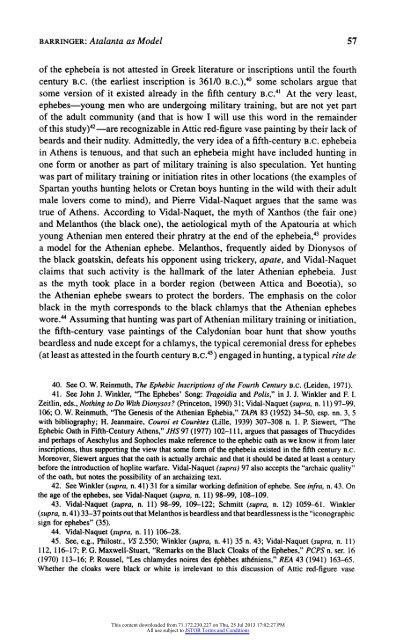Atalanta as Model: The Hunter and the Hunted - Robert Bedrosian's ...
Atalanta as Model: The Hunter and the Hunted - Robert Bedrosian's ...
Atalanta as Model: The Hunter and the Hunted - Robert Bedrosian's ...
Create successful ePaper yourself
Turn your PDF publications into a flip-book with our unique Google optimized e-Paper software.
BARRINGER: <strong>Atalanta</strong> <strong>as</strong> <strong>Model</strong> 57<br />
of <strong>the</strong> ephebeia is not attested in Greek literature or inscriptions until <strong>the</strong> fourth<br />
century B.C. (<strong>the</strong> earliest inscription is 361/0 B.C.),40 some scholars argue that<br />
some version of it existed already in <strong>the</strong> fifth century B.c.41 At <strong>the</strong> very le<strong>as</strong>t,<br />
ephebes-young men who are undergoing military training, but are not yet part<br />
of <strong>the</strong> adult community (<strong>and</strong> that is how I will use this word in <strong>the</strong> remainder<br />
of this study)42--are recognizable in Attic red-figure v<strong>as</strong>e painting by <strong>the</strong>ir lack of<br />
beards <strong>and</strong> <strong>the</strong>ir nudity. Admittedly, <strong>the</strong> very idea of a fifth-century B.C. ephebeia<br />
in A<strong>the</strong>ns is tenuous, <strong>and</strong> that such an ephebeia might have included hunting in<br />
one form or ano<strong>the</strong>r <strong>as</strong> part of military training is also speculation. Yet hunting<br />
w<strong>as</strong> part of military training or initiation rites in o<strong>the</strong>r locations (<strong>the</strong> examples of<br />
Spartan youths hunting helots or Cretan boys hunting in <strong>the</strong> wild with <strong>the</strong>ir adult<br />
male lovers come to mind), <strong>and</strong> Pierre Vidal-Naquet argues that <strong>the</strong> same w<strong>as</strong><br />
true of A<strong>the</strong>ns. According to Vidal-Naquet, <strong>the</strong> myth of Xanthos (<strong>the</strong> fair one)<br />
<strong>and</strong> Melanthos (<strong>the</strong> black one), <strong>the</strong> aetiological myth of <strong>the</strong> Apatouria at which<br />
young A<strong>the</strong>nian men entered <strong>the</strong>ir phratry at <strong>the</strong> end of <strong>the</strong> ephebeia,43 provides<br />
a model for <strong>the</strong> A<strong>the</strong>nian ephebe. Melanthos, frequently aided by Dionysos of<br />
<strong>the</strong> black goatskin, defeats his opponent using trickery, apate, <strong>and</strong> Vidal-Naquet<br />
claims that such activity is <strong>the</strong> hallmark of <strong>the</strong> later A<strong>the</strong>nian ephebeia. Just<br />
<strong>as</strong> <strong>the</strong> myth took place in a border region (between Attica <strong>and</strong> Boeotia), so<br />
<strong>the</strong> A<strong>the</strong>nian ephebe swears to protect <strong>the</strong> borders. <strong>The</strong> emph<strong>as</strong>is on <strong>the</strong> color<br />
black in <strong>the</strong> myth corresponds to <strong>the</strong> black chlamys that <strong>the</strong> A<strong>the</strong>nian ephebes<br />
wore.44 Assuming that hunting w<strong>as</strong> part of A<strong>the</strong>nian military training or initiation,<br />
<strong>the</strong> fifth-century v<strong>as</strong>e paintings of <strong>the</strong> Calydonian boar hunt that show youths<br />
beardless <strong>and</strong> nude except for a chlamys, <strong>the</strong> typical ceremonial dress for ephebes<br />
(at le<strong>as</strong>t <strong>as</strong> attested in <strong>the</strong> fourth century B.C.45) engaged in hunting, a typical rite de<br />
40. See O. W. Reinmuth, <strong>The</strong> Ephebic Inscriptions of <strong>the</strong> Fourth Century B.C. (Leiden, 1971).<br />
41. See John J. Winkler, "<strong>The</strong> Ephebes' Song: Tragoidia <strong>and</strong> Polis," in J. J. Winkler <strong>and</strong> F. I.<br />
Zeitlin, eds., Nothing to Do With Dionysos? (Princeton, 1990) 31; Vidal-Naquet (supra, n. 11) 97-99,<br />
106; 0. W. Reinmuth, "<strong>The</strong> Genesis of <strong>the</strong> A<strong>the</strong>nian Ephebia," TAPA 83 (1952) 34-50, esp. nn. 3, 5<br />
with bibliography; H. Jeanmaire, Couroi et Couretes (Lille, 1939) 307-308 n. 1. P. Siewert, "<strong>The</strong><br />
Ephebic Oath in Fifth-Century A<strong>the</strong>ns," JHS 97 (1977) 102-111, argues that p<strong>as</strong>sages of Thucydides<br />
<strong>and</strong> perhaps of Aeschylus <strong>and</strong> Sophocles make reference to <strong>the</strong> ephebic oath <strong>as</strong> we know it from later<br />
inscriptions, thus supporting <strong>the</strong> view that some form of <strong>the</strong> ephebeia existed in <strong>the</strong> fifth century B.C.<br />
Moreover, Siewert argues that <strong>the</strong> oath is actually archaic <strong>and</strong> that it should be dated at le<strong>as</strong>t a century<br />
before <strong>the</strong> introduction of hoplite warfare. Vidal-Naquet (supra) 97 also accepts <strong>the</strong> "archaic quality"<br />
of <strong>the</strong> oath, but notes <strong>the</strong> possibility of an archaizing text.<br />
42. See Winkler (supra, n. 41) 31 for a similar working definition of ephebe. See infra, n. 43. On<br />
<strong>the</strong> age of <strong>the</strong> ephebes, see Vidal-Naquet (supra, n. 11) 98-99, 108-109.<br />
43. Vidal-Naquet (supra, n. 11) 98-99, 109-122; Schmitt (supra, n. 12) 1059-61. Winkler<br />
(supra, n. 41) 33-37 points out that Melanthos is beardless <strong>and</strong> that beardlessness is <strong>the</strong> "iconographic<br />
sign for ephebes" (35).<br />
44. Vidal-Naquet (supra, n. 11) 106-28.<br />
45. See, e.g., Philostr., VS 2.550; Winkler (supra, n. 41) 35 n. 43; Vidal-Naquet (supra, n. 11)<br />
112, 116-17; P. G. Maxwell-Stuart, "Remarks on <strong>the</strong> Black Cloaks of <strong>the</strong> Ephebes," PCPS n. ser. 16<br />
(1970) 113-16; P. Roussel, "Les chlamydes noires des ephebes ath6niens," REA 43 (1941) 163-65.<br />
Whe<strong>the</strong>r <strong>the</strong> cloaks were black or white is irrelevant to this discussion of Attic red-figure v<strong>as</strong>e<br />
This content downloaded from 71.172.230.227 on Thu, 25 Jul 2013 17:02:27 PM<br />
All use subject to JSTOR Terms <strong>and</strong> Conditions
















